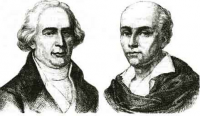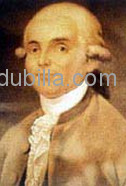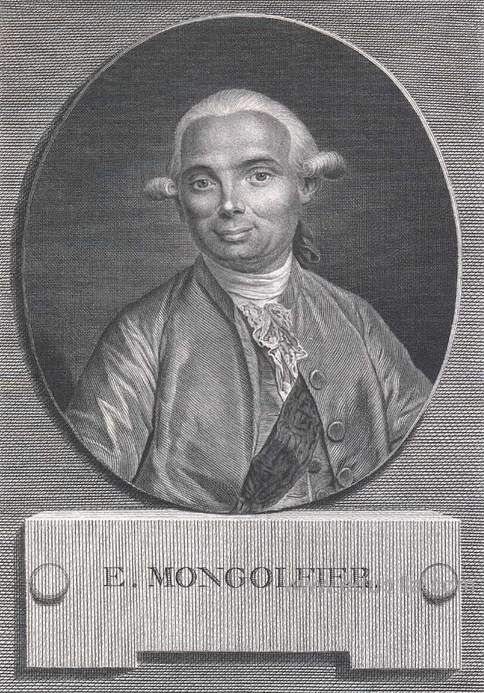










Joseph-Michel Montgolfier and Jacques-Étienne Montgolfier were the inventors of the Montgolfière-style hot air balloon, globe aérostatique. The brothers succeeded in launching the first manned ascent, carrying Étienne into the sky. Later, in December 1783, in recognition of their achievement, their father Pierre was elevated to the nobility and the hereditary appellation of de Montgolfier by King Louis XVI of France.
Early years
The brothers were born into a family of paper manufacturers in Annonay, in Ardèche, France. Their parents were Pierre Montgolfier (1700–1793) and his wife, Anne Duret (1701–1760), who had sixteen children. Pierre established his eldest son, Raymond Montgolfier, later Raymond de Montgolfier (1730–1772), as his successor.
Joseph, the 12th child, possessed a typical inventor's temperament—a maverick and dreamer, and impractical in terms of business and personal affairs. Étienne had a much more even and businesslike temperament. As the 15th child, and particularly troublesome to his elder siblings, he was sent to Paris to train as an architect. However, after the sudden and unexpected death of Raymond in 1772, he was recalled to Annonay to run the family business. In the subsequent 10 years, Étienne applied his talent for technical innovation to the family business; paper making was a high-tech industry in the 18th century. He succeeded in incorporating the latest Dutch innovations of the day into the family mills. His work led to recognition by the government of France as well as the awarding of a government grant to establish the Montgolfier factory as a model for other French paper makers.
Early experiments
Of the two brothers, it was Joseph who first contemplated building machines as early as 1777 when he observed laundry drying over a fire incidentally form pockets that billowed upwards.Joseph made his first definitive experiments in November 1782 while living in the city of Avignon. He reported some years later that he was watching a fire one evening while contemplating one of the great military issues of the day—an assault on the fortress of Gibraltar, which had proved impregnable from both sea and land.Joseph mused on the possibility of an air assault using troops lifted by the same force that was lifting the embers from the fire. He believed that contained within the smoke was a special gas, which he called Montgolfier Gas, with a special property he called levity.
As a result of these musings, Joseph set about building a box-like chamber 1×1×1.3 m (3 ft by 3 ft (0.91 m) by 4 ft) out of very thin wood, and covering the sides and top with lightweight taffeta cloth. He crumpled and lit some paper under the bottom of the box. The contraption quickly lifted off its stand and collided with the ceiling. Joseph then recruited his brother to balloon building by writing, "Get in a supply of taffeta and of cordage, quickly, and you will see one of the most astonishing sights in the world." The two brothers then set about building a similar device, scaled up by three (so 27 times greater in volume). The lifting force was so great that they lost control of their craft on its very first test flight on 14 December 1782. The device floated nearly two kilometers (about 1.2 mi). It was destroyed after landing by the "indiscretion" of passersby.
Public demonstrations
The brothers decided to make a public demonstration of a balloon in order to establish their claim to its invention. They constructed a globe-shaped balloon of sackcloth with three thin layers of paper inside. The envelope could contain nearly 790 m³ (28,000 cubic feet) of air and weighed 225 kg (500 lb). It was constructed of four pieces (the dome and three lateral bands) and held together by 1,800 buttons. A reinforcing fish net of cord covered the outside of the envelope.
On 4 June 1783, they flew this craft as their first public demonstration at Annonay in front of a group of dignitaries from the États particuliers. Its flight covered 2 km (1.2 mi), lasted 10 minutes, and had an estimated altitude of 1,600-2,000 m (5,200-6,600 ft). Word of their success quickly reached Paris. Étienne went to the capital to make further demonstrations and to solidify the brothers' claim to the invention of flight. Joseph, given his unkempt appearance and shyness, remained with the family. Étienne was the epitome of sober virtues ... modest in clothes and manner...
In collaboration with the successful wallpaper manufacturer Jean-Baptiste Réveillon, Étienne constructed a 37,500-cubic-foot (1,060 m3) envelope of taffeta coated with a varnish of alum (which has fireproofing properties). The balloon was sky blue and decorated with golden flourishes, signs of the zodiac, and suns. The design showed the intervention of Réveillon. The next test was on the 11th of September from the grounds of la Folie Titon, close to Réveillon's house. There was some concern about the effects of flight into the upper atmosphere on living creatures. The king proposed to launch two criminals, but it is most likely that the inventors decided to send a sheep, a duck, and a rooster aloft first.
On the 19th of September 1783, the Aérostat Réveillon was flown with the first living beings in a basket attached to the balloon: a sheep called Montauciel ("Climb-to-the-sky"), a duck and a rooster. The sheep was believed to have a reasonable approximation of human physiology. The duck was expected to be unharmed by being lifted aloft. It was included as a control for effects created by the aircraft rather than the altitude. The rooster was included as a further control as it was a bird that did not fly at high altitudes. This demonstration was performed before a crowd at the royal palace in Versailles, before King Louis XVI of France and Queen Marie Antoinette.
The flight lasted approximately eight minutes, covered two miles (3 km), and obtained an altitude of about 1,500 feet (460 m). The craft landed safely after flying.

